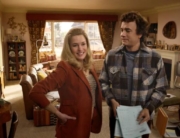Mystery/suspense films are usually referred to as B-movies because of their cheap thrills. But when they’re done artfully, as in The Blue Room, they’re as rich as any type of film. Tight writing, superior performances, judicious editing, and extremely well-composed frames elevate The Blue Room to a level of class that is thoughtful and very pleasurable.
Julien (Mathieu Almaric) and Esther (Stéphanie Cléau) meet often in a hotel room to hold a passionate affair. (He looks for a signal from the window above the pharmacy where she works.) Their sweaty bodies collide, making love over and over, eventually leading to a bite on Julien’s lip. His wife (Léa Drucker) notices it, and as suspicions build, so does the pressure from his mistress for them to be together forever. A death occurs, and Julien scrambles for his life as he’s interrogated by police, psychologists, and the court system. Every detail of his private life is examined with a fine teeth comb, but the truth remains often elusive.
The Blue Room provides a constant guessing game of what will happen next, but beyond that we have actors giving subtle and emotionally charged performances. Glares and glances feel loaded with suspicion, and smiles are sometimes loaded with years of repression. Primarily known as an actor, Mathieu Almaric makes bold choices as the director. For one, the film was shot with a narrow 1:33 aspect ratio, emphasizing the intimacy of the story. It was also largely filmed with close shots, directing our eyes to details we may not have noticed—a drop of blood here, a drop of jam there.
There are very few camera movements so the film is mostly told in edits, often jumping back and forth in time and juxtaposing conflicting images. At one point, the film cuts from a close-up of Julien’s mistress’s legs spreading wide to an image of his sleeping daughter. Those are modern flourishes you wouldn’t see in a classic mystery film, yet The Blue Room has the feel of a Alfred Hitchcock or Claude Chabrol film.
Hitchcock preferred to refer to editing as “assembling” rather than “cutting,” as assembling is additive and implies creating a whole out of pieces, and that certainly applies here. And Chabrol’s mystery/suspense films, like Le Boucher (1967), often come off as psychological investigations, not simply as plot-heavy whodunits. The Blue Room’s “classic” feel is also due to the score by Grégoire Hetzel, which is at times quiet and pensive and at other times romantic and sweeping. All in all, The Blue Room satisfies all of the senses, from auditory to visual and primal to contemplative.







Leave A Comment